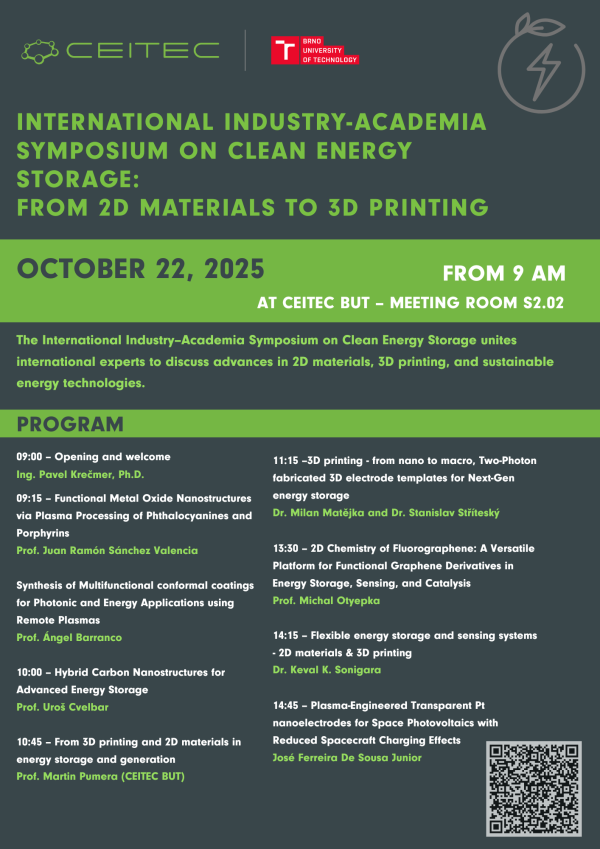Abstracts
Prof. Juan Ramón Sánchez Valencia: Functional Metal Oxide Nanostructures via Plasma Processing of Phthalocyanines and Porphyrins
Controlling nanostructure morphology is essential for engineering advanced materials with tailored functionalities. In this context, plasma-assisted deposition techniques have evolved beyond compactthin films, enabling the fabrication of nanoporous layers, low-dimensional carbon structures, and complex one-dimensional architectures. These methods offer scalability, low deposition temperatures, wide substrate compatibility, precise compositional control (including doping), and morphological precision (including microstructure, texture, and alignment). A major challenge, however, lies in the limited availability of suitable volatile metalorganic and metal halide precursors for nanoscale deposition.
This work establishes the basis for a vacuum and plasma-supported methodology for fabricating highly conformal metal-oxide layers with controlled nanostructure using metal phthalocyanines and porphyrins as precursors. Key strengths of this method are its ample general character from the point of view of the material composition and microstructure, mild deposition and processing temperature and energy constraints, and compatibility with the direct deposition on processable substrates and device architectures. Leveraging commercially available metal porphyrins and phthalocyanines, we developed metal oxide layers, including CuO, Fe2O3, TiO2, VOx, MnOx, and ZnO, with morphologies ranging from compact to porous films, as well as low-dimensional nanostructures such as 2D networks, nanowires, or nanocolumns. The synthesized layers demonstrate potential in energy applications, including optoelectronics, smart windows, and supercapacitors.
Prof. Ángel Barranco: Synthesis of Multifunctional conformal coatings for Photonic and Energy Applications using Remote Plasmas
The Remote Plasma Assisted Vacuum Deposition (RPAVD) process stands as a versatile methodology for fabricating functional nanocomposites from non-chemically polymerizable organic functional molecules and functional metal coordination compounds. This approach combines the physicochemical reactions inherent to plasma polymerization processes with the vapor deposition of functional molecules tailored to the specific demands of target applications. The resultant cross-linked polymer thin films exhibit insolubility and exceptional thermal stability. These films can incorporate a precise concentration of virtually any thermally stable, photo-functional molecule.
The method exhibits wafer scalability and compatibility with solvent-sensitive, delicate substrates and supported nanostructures. Initially, this process was applied to developing thin optical films and photonic devices, encompassing optical filters, photonic sensing chips, and lasing media. Nevertheless, the film properties can be fine-tuned for various other functional applications, such as creating controlled wetting and ice-retarding surfaces, antimicrobial coatings, and high-performance dielectric ultrathin films.
In this presentation, we will also showcase recent results about the encapsulation of nanostructures on surfaces and its role in encapsulating and modifying perovskite solar cells and the fabrication of inorganic functional coatings. The talk will include a brief overview of the Nanotechnology on Surfaces and Plasma Laboratory at the ICMS-CSIC in Seville, focusing on the development of functional materials through plasma deposition and processing.
Prof. Uroš Cvelbar - Hybrid Carbon Nanostructures for Advanced Energy Storage
This abstract highlights the potential of plasma-assisted approaches to advance the research on hybrid carbon nanostructures by designing, tailoring, and upscaling their energy storage properties. This offers a pathway towards more efficient and sustainable storage solutions for next-generation energy devices. Plasma offers diverse advantages, allowing for the eco-friendly assembly of carbon nanostructures directly on substrates, transitioning from gaseous to solid states or from solid-to-solid forms with predefined orientations (vertical or horizontal), dimensions (1D-3D), and morphologies. Furthermore, plasma enables controlled surface tailoring using desired functional/heteroatoms in a greener approach. Recent advancements in plasma-designed carbon hybrids have demonstrated superior performance for energy storage. Noteworthy cases include the single-step plasma-enabled approach for N-graphene-metal-oxide(sulfide) hybrid nanostructures, advanced carbon-nickel sulfide hybrid nanostructures for redox-based supercapacitors and carbon nanoforests for filtering capacitors.
Prof. Pumera: From 3D printing and 2D materials in energy storage and generation
Additive manufacturing and atomically thin materials are reshaping how we design, fabricate, and integrate electrochemical systems for energy generation. This talk will chart a path “from 3D printing to 2D materials,” highlighting how digitally engineered architectures married with high–surface area, conductive, and electrochemically active nanosheets unlock new performance regimes. I will discuss ink formulation and print strategies (direct-ink writing, stereolithography, and multi-material printing) for various material composites that yield hierarchical porosity, short ion-transport pathways, and robust current collectors. Case studies will include printed micro-supercapacitors and electrodes with elevated areal capacitance and rate capability. Beyond performance metrics, the talk will address manufacturability—rheology control, interlayer adhesion, physical and chemical post-processing, including plasma treatment—and durability under real operating conditions. I will conclude with perspectives on sustainability, recyclability, and standardization needed to transition 3D-printed, 2D-material energy technologies from the lab to industry.
IQS Nano- Dr. Milan Matějka a Dr. Stanislav Střítezský- 3D printing - from nano to macro, Two-Photon fabricated 3D electrode templates for Next-Gen energy storage
We present a novel method for fabricating 3D electrode scaffolds using two-photon polymerization (2PP), developed within the ANGSTROM project. These high-precision templates serve as structured platforms for the deposition of porous, redox-active materials such as COFs and metal oxides via plasma processes. The combination of 2PP and plasma engineering enables the creation of multifunctional electrodes with controlled architecture, high surface area, and excellent electrochemical performance. This approach offers a scalable path to advanced supercapacitors with high energy density and long-term cycling stability.
Prof. Michal Otyepka: 2D Chemistry of Fluorographene: A Versatile Platform for Functional Graphene Derivatives in Energy Storage, Sensing, and Catalysis
Covalent functionalization of graphene provides a powerful route to tailor its electronic, magnetic, and surface properties, but pristine graphene’s low chemical reactivity typically necessitates harsh reaction conditions. To overcome this limitation, we have pioneered the use of fluorographene (FG), a stoichiometric graphene derivative (C₁F₁) conveniently obtained by chemical delamination of commercially available graphite fluoride, as a versatile precursor for the controlled synthesis of functional graphene derivatives. FG undergoes nucleophilic substitution under mild, controllable conditions, enabling the preparation of a wide library of derivatives with diverse functionalities. The graphene derivatives obtained via chemistry of FG can be used in multiple application areas. In energy storage, FG-derived graphene acid and its analogues have shown excellent performance as electrode materials for supercapacitors, Li-ion, and Li–S batteries, bridging the gap between material-level properties and device-level performance. In sensing, derivatives such as nitrogen-doped graphene acid can be inkjet-printed into reproducible, miniaturized electrochemical sensors for pesticides, pH monitoring, and other analytes, offering low-cost, scalable platforms for point-of-need diagnostics. In catalysis, FG-based materials, including graphene acid, cyanographene, and taurine-functionalized graphene, have been exploited as metal-free catalysts or single-atom catalyst (SAC) supports for a range of key transformations, including aerobic alcohol oxidation, selective benzylic C–H oxidation, and glycerol valorization to solketal. These developments collectively demonstrate that FG chemistry is not merely a synthetic curiosity but a robust and modular strategy for designing next-generation carbon materials. The ability to access well-defined, solution-processable graphene derivatives under mild conditions makes FG chemistry a cornerstone for the development of sustainable technologies across catalysis, energy storage, and chemical/biological sensing.
Dr. Keval K. Sonigara: Flexible energy storage and sensing systems - 2D materials & 3D printing
The increasing demand for next-generation sensors and wearable electronics requires adaptable, resilient, and sustainable energy solutions. The primary considerations are safety, flexibility, comfort, and biocompatibility. To meet these criteria, careful material selection and specialized device engineering are essential, such as aqueous energy storage devices, which offer benign safety and flexibility in device designs suitable for wearable applications. This session will provide an overview of recent advances in flexible and wearable devices, emphasizing the role of two-dimensional (2D) materials in transforming flexible energy storage devices and sensors. Specifically, it will cover the development of aqueous supercapacitors, batteries, and wearable sensors derived from advanced 2D materials, including MXene and the metal thiophosphate family. This includes detailed strategies for achieving mechanical robustness, biocompatibility, and high electrochemical performance in wearable formats. The presentation will showcase proof-of-concept textile-based remote health monitoring systems that integrate energy storage devices and biosensors, capable of collecting real-time physiological data and transmitting it wirelessly for telemedicine applications. In addition, the role of 3D printing technologies, especially the electrochemical fabrication of 2D zinc anodes, will be explored to engineer complex, application-specific device architectures that advance the next generation of smart, wearable systems.
José Ferreira De Sousa Junior - Plasma-Engineered Transparent Pt nanoelectrodes for Space Photovoltaics with Reduced Spacecraft Charging Effects
Spacecraft charging is a well-documented phenomenon caused by interactions between spacecraft and the surrounding space environment, including plasma, solar radiation, and high-energy particles. This can result in significant electrical charge accumulation, triggering electrostatic discharges (ESD), and is a major source of critical failures in spacecraft systems (e.g., space solar arrays).
This research addresses spacecraft charging in space photovoltaics by developing innovative Pt-based transparent nanoelectrodes applied to solar cell cover glasses. These coatings consist of percolated platinum nanonetworks fabricated by sequentially combining two industrially scalable plasma processes in a single reactor: (i) remote plasma-assisted vacuum deposition (RPAVD) of a hybrid Pt plasma-polymer nanocomposite, and (ii) room-temperature plasma etching of the resulting layer.[1]-[3] These coatings, featuring laterally interconnected Pt nanonetworks, achieve solar transmittance above 85% while maintaining low sheet resistance.
The spacecraft charging mitigation performance of the coatings was evaluated using advanced characterisation techniques, including secondary electron emission yield, vacuum ultraviolet (VUV) photoemission, and sheet resistance measurements in vacuum at controlled temperature. Additionally, SPENVIS’ EQUIPOT and SPIS-6 simulations were employed to model surface charging and potential behaviour of a model satellite in various orbits. Simulation results confirm that the developed Pt nanonetwork coatings provide effective protection against spacecraft charging, making them a promising solution for enhancing the durability and performance of photovoltaic solar arrays in space.


 Share
Share
